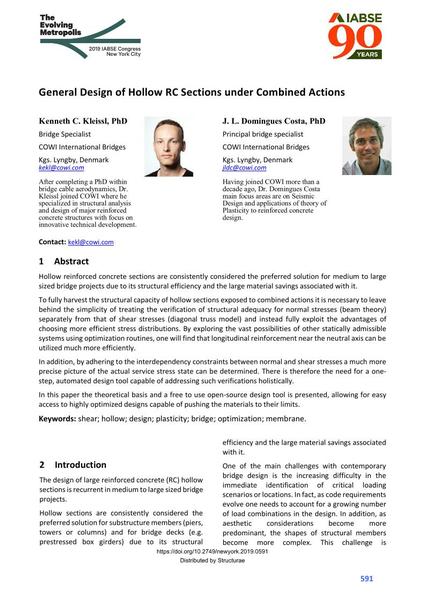General Design of Hollow RC Sections under Combined Actions

|
|
|||||||||||
Bibliographic Details
| Author(s): |
Kenneth C. Kleissl
(COWI International Bridges)
J. L. Domingues Costa (COWI International Bridges) |
||||
|---|---|---|---|---|---|
| Medium: | conference paper | ||||
| Language(s): | English | ||||
| Conference: | IABSE Congress: The Evolving Metropolis, New York, NY, USA, 4-6 September 2019 | ||||
| Published in: | The Evolving Metropolis | ||||
|
|||||
| Page(s): | 591-596 | ||||
| Total no. of pages: | 6 | ||||
| DOI: | 10.2749/newyork.2019.0591 | ||||
| Abstract: |
Hollow reinforced concrete sections are consistently considered the preferred solution for medium to large sized bridge projects due to its structural efficiency and the large material savings associated with it. To fully harvest the structural capacity of hollow sections exposed to combined actions it is necessary to leave behind the simplicity of treating the verification of structural adequacy for normal stresses (beam theory) separately from that of shear stresses (diagonal truss model) and instead fully exploit the advantages of choosing more efficient stress distributions. By exploring the vast possibilities of other statically admissible systems using optimization routines, one will find that longitudinal reinforcement near the neutral axis can be utilized much more efficiently. In addition, by adhering to the interdependency constraints between normal and shear stresses a much more precise picture of the actual service stress state can be determined. There is therefore the need for a one- step, automated design tool capable of addressing such verifications holistically. In this paper the theoretical basis and a free to use open-source design tool is presented, allowing for easy access to highly optimized designs capable of pushing the materials to their limits. |
||||
| Keywords: |
design bridge optimization membrane shear plasticity hollow
|
||||
